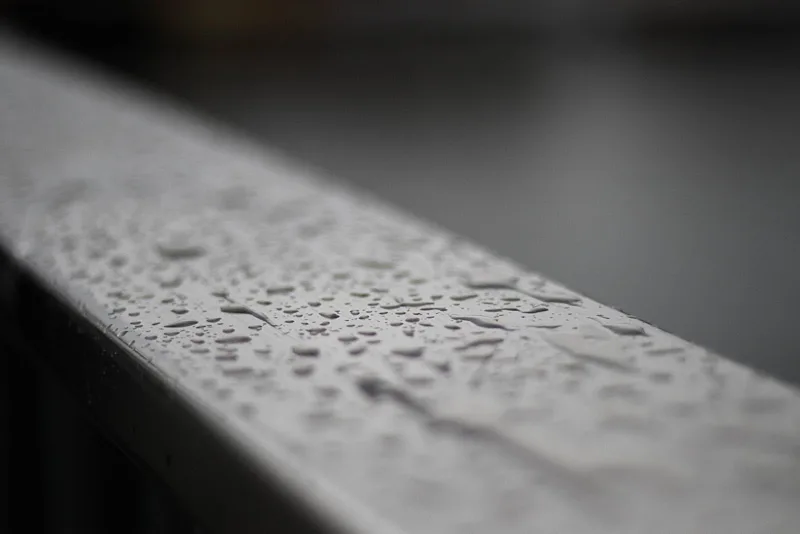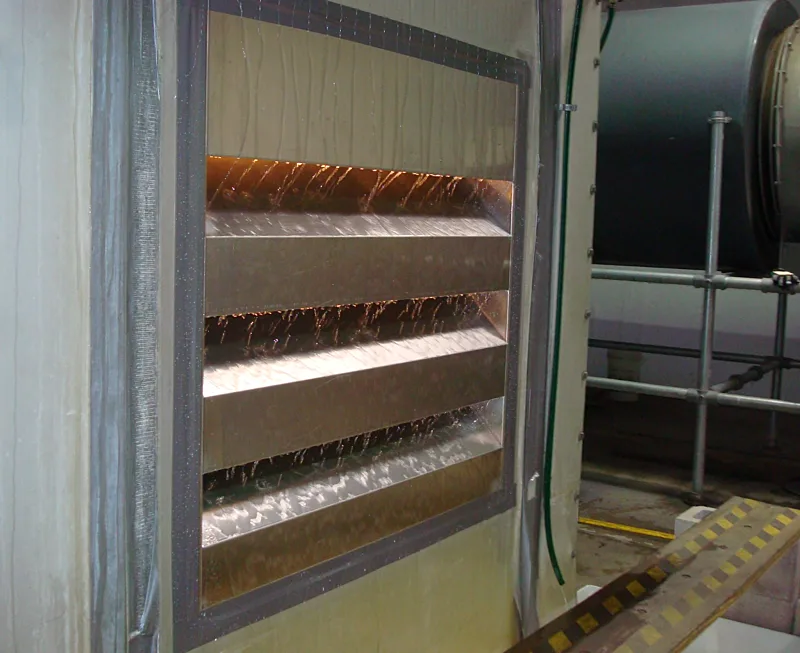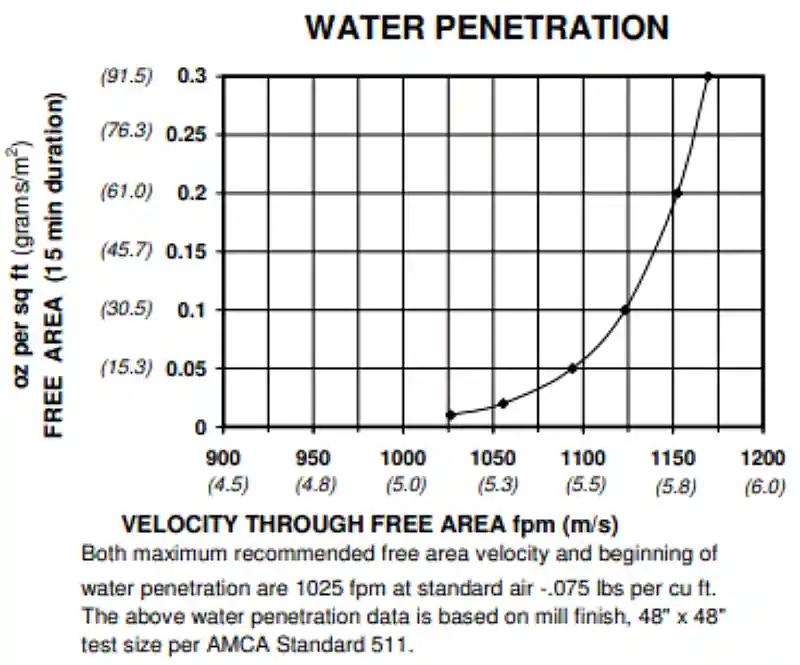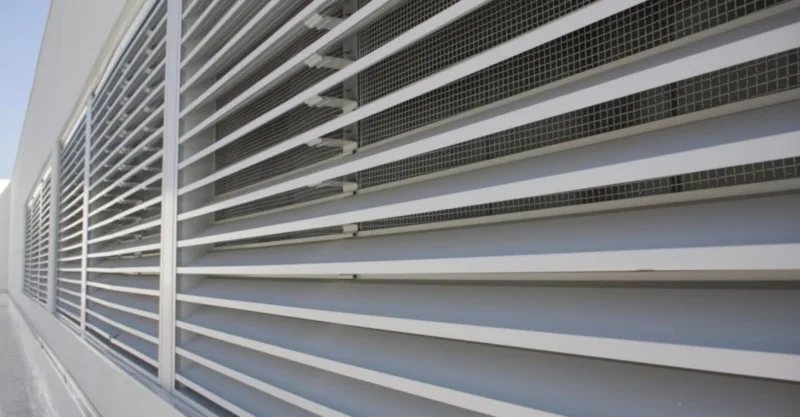Louvers are specifically designed to protect spaces within a building from rain, wind, and snow while ensuring good ventilation. This is made possible by the design of the louver blade in addition to the built-in gutters and drainage channels.
However, all louvers aren't built equally, and some may not be effective against rain or heavy winds. When these louvers are providing protection for machinery or equipment, which must stay dry or free of debris, the performance of these louvers is especially critical. That's why, when selecting louver products for your ventilation system, make sure that they provide adequate water penetration protection.

To ensure that the information provided by a manufacturer is accurate, it is recommended only to choose louvers that have been AMCA Certified and include an AMCA CRP Seal. This testing protocol allows engineers to compare manufacturer’s products against each other to decide which is best for their application.
Louvers’ Testing and Certification Regulatory Authority: Air Movement And Control Association (AMCA)
AMCA is a regulatory authority that establishes guidelines for louvers. It ensures the reliability of louvers for various purposes by testing them in many different ways. Some of the different types of testing include water penetration, air leakage, pressure drop, wind-driven rain, and wind-driven sand.
The Importance Of Getting The Louvers Rated By AMCA
The AMCA seal with appropriate ratings will help you determine the reliability of the product. Once the product is tested in accredited labs, it's provided with an AMCA rating seal. Buyers look for the seal as a sign of authentication when buying air-control products. AMCA International’s Certified Ratings Program (CRP) ensures manufacturers maintain standards over time by requiring check testing at regular intervals.
These tests are not conducted to pass or fail any products, but rather to authenticate the louvers and endorse a rating according to their capability and purpose.
AMCA Seal for Water Penetration and Air Performance
This article will review the test protocols and requirements for a louver to get a Water Penetration seal by AMCA, and what the process entails. This is covered in AMCA Standard 500-L.
Water Penetration Test For Louvers
AMCA accredited labs have special parameters and comprehensive simulation systems that mimic inclement weather, testing a louver to its limit. These products are put through rigorous conditions that they might have to face in real-world settings. For the simulated still air rainfall test, the test system consists of ductwork connected to an exhaust fan on one end and a louver on the other end.
The louver is put into conditions for the water penetration test, which will show how it will perform under ‘typical’ conditions. Wind-driven rain conditions are not included in this test.
For the simulated still air rainfall test, the test system consists of ductwork connected to an exhaust fan on one end and a louver on the other end.
AMCA Test of AWV Louvers

For the sample, labs prefer square-shaped louvers with each side measuring 48 inches. The louver is tested with no accessories or finish included.
A series of nozzles are placed in front of the wall and slightly above the louver opening. The nozzles create water droplets to mimic the rain. These droplets are sucked into the louver as the intake draws air into the duct. This simulates rainfall in still air conditions.
This particular test is designed to simulate the working of an intake duct that we usually see on the side of buildings.
This test goes on for 15 minutes, and as soon as the air flowing in the duct reaches 1250 FPM or 2.5 ounces of water enters the system, the test is stopped, and it is marked completed by the testing personnel.
Four data results are extracted in the process, each noted at four different key points of air velocity.
This test's conditions include 4" light vertical rain per hour at 1,250 fpm max. The test analyzes the beginning point of water penetration based on free area velocity.
Extracting Data Insights From The Simulation
With each test, 4 key points of data are extracted in 2 sets:
The amount of water that enters the duct during the simulation
The free area velocity: the speed of air moving through the louver
The beginning point of water penetration is the speed at which 0.01 oz/sqft passes through the louver over a 15 minute period.
The extracted results are plotted on a graph; different points are marked as the water penetration increases with the free area velocity. Regression analysis is used to plot an accurate curve of the results.
The line on the graph starts from the beginning point of water penetration and is denoted as "X'. The same line from the beginning point to the max amount of free area velocity will help determine how much water penetration one can expect at what particular airspeed.
In some cases, there is no line, but only a dot, as the test shows no water penetration at all, even when the free area velocity reaches the 1250 FPM mark.

Water Penetration Chart extract from louver submittal document.
Different Criteria That Demonstrate The Test Data
According to the AMCA Standard 500-L water penetration test, the test results include information on the personnel involved during the testing, the date it was performed, the test ID number, lab name, and the lab location.
Along with this, the test results also include a reference to the AMCA Standard 500-L, test figures, louver specifications such as model and type size, free area, and any accessories attached to the louver such as a drain pan.
Especially when there is no adequate drainage system, the water penetration test is useful for the testing personnel as the louver needs to be kept dry at all times.
How To Find The Right Louver
The key to selecting the best louver for your application is understanding your application requirements. No louver is ever effective at stopping all water from entering the building opening. The key is to find the louver that prevents most, to all, water penetration at the system velocity required, while minimizing the resulting pressure drop.
Other factors that determine the efficacy of a louver include:
Louver application
Louver Blade type
Louver Blade angle, spacing and orientation
Louver depth
Air volume and velocity
For most applications, without concerns of wind driven rain, a high-performing drainable blade louver will be the best product from a cost/benefit perspective. Look for those with a higher beginning point of water penetration and lower pressure drop.

Note that the water penetration test is only designed for testing a louver with the stimulation of light, to no, wind conditions. For wind-driven rain, AMCA has established a separate test setup and procedure, within AMCA Standard 500-L.
In addition to this, AMCA has recently developed the Standard 540/550 Test Method for louvers affected by Wind Borne Debris and High Velocity Wind Driven Rain. You can find these standards here.
AMCA ratings are a great resource to help you find the best louvers
Choosing the right louver often depends on the needs, its placement, and the weather conditions of the area. Look for AMCA ratings and water penetration test results to find the best louver for normal conditions with minimal wind exposure.
Don’t forget to consider the other factors that come into play for deeming a louver effective. Always check the AMCA seal on the product when choosing the best louvers to suit your needs.
For more information on durable louvers with high water penetration resistance, contact the experts at AWV today.







